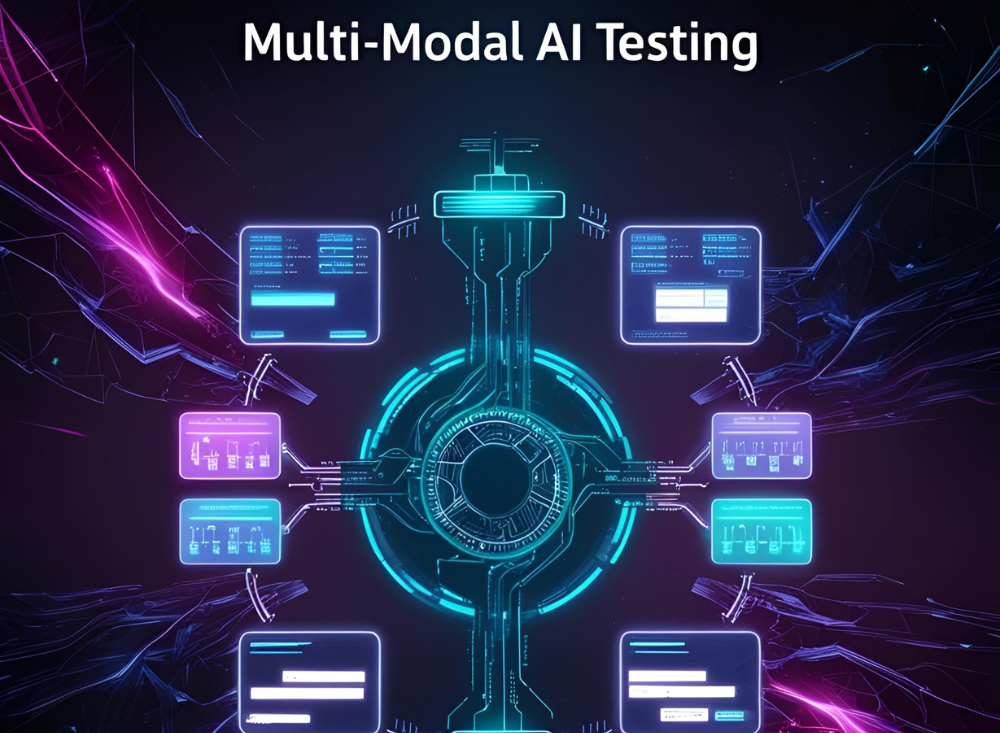
Multi-modal systems introduce a unique blend of challenges:
- Data Variability: Inputs can be natural language, gestures, audio, or images—sometimes all at once.
- Non-Deterministic Outputs: AI-generated responses vary depending on input context and learned behavior.
- Cross-Modality Interaction: A spoken command may trigger a visual result, which must be tested end-to-end.
- Contextual Reasoning: Systems must process relationships between modalities in real time.
Traditional test automation simply can’t keep up. Genqe.ai reimagines testing with AI at its core.
How Genqe.ai Powers QA for Multi-Modal AI
Here’s how Genqe.ai addresses the complexities of testing multi-modal AI systems:
AI-Powered Test Generation for Multi-Modal Workflows
Genqe.ai automatically identifies and models real-world user flows across voice, text, image, and video interactions. For example:
- Testing a virtual assistant that responds to both voice and visual cues
- Ensuring accurate transcription + visual content delivery in e-learning tools
- Validating gesture-to-command interpretation in smart devices
Tests are context-aware, scenario-driven, and self-maintaining.
Visual + Contextual Validation in One Platform
Multi-modal UIs are dynamic and often involve both content recognition and visual consistency. Genqe.ai combines:
- Visual Regression Testing: Detect UI anomalies across devices and resolution changes
- Contextual Testing: Validate that generated content matches expected context from prior modalities
For example, if a spoken query returns a data chart, Genqe.ai checks both the correctness of the chart and the alignment with the user query.
Self-Healing Tests Across Modalities
Multi-modal apps evolve rapidly. With Genqe.ai:
- Broken test steps auto-heal using AI pattern recognition
- Test cases adapt as AI model responses evolve
- QA teams don’t need to rewrite test logic every time the UI or behavior shifts
This is key for systems that learn and improve over time.
API + Front-End Testing in Sync
Most multi-modal systems rely heavily on APIs and backend AI services. Genqe.ai ensures:
- End-to-end coverage of API responses triggered by user actions
- Synchronization between what’s processed in the backend and rendered to the user
- Integrated validation of speech-to-text, image rendering, and content playback
All within a unified, low-code test environment.
Intelligent Reporting for AI-Driven Workflows
With Genqe.ai’s real-time dashboards and smart analytics:
- Identify which modality is responsible for test failures
- Prioritize test coverage based on user engagement trends
- Track regression risk across voice, text, and visual layers
This insight-first QA helps teams build better, faster AI systems.
Key Advantages for Multi-Modal Testing with Genqe.ai
| Challenge | Genqe.ai Solution |
|---|---|
| High-dimensional input combinations | AI-generated scenario modeling across modalities |
| Constantly learning systems | Self-healing, adaptive test cases |
| Visual + behavioral validation | Visual regression + context checking |
| Fragmented back-end and front-end logic | Unified API + front-end testing pipelines |
| Lack of traditional scripting resources | Codeless automation for technical and non-technical users |
Real-World Example: Testing a Multi-Modal Health App
Imagine a user uploading an image of a skin rash, describing symptoms via voice, and receiving treatment suggestions visually. With Genqe.ai:
- The image upload is validated against expected formats
- Voice-to-text conversion is checked for accuracy
- The diagnosis UI is verified visually and contextually
- All backend API interactions are logged and tested in parallel
No scripting. No guesswork. Just smart automation, start to finish.
Conclusion: Genqe.ai is the Future of Multi-Modal QA
Testing AI systems that think and communicate across modalities requires a paradigm shift in QA. With Genqe.ai, you get:
- AI-native, codeless testing
- Multi-modal scenario coverage
- Resilient automation with real-time insights
In 2025 and beyond, delivering intelligent user experiences starts with intelligent QA—powered by Genqe.ai.